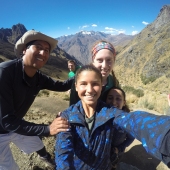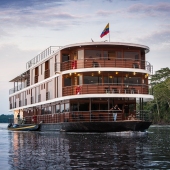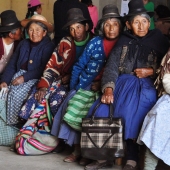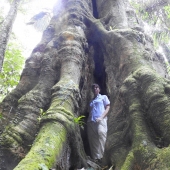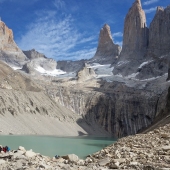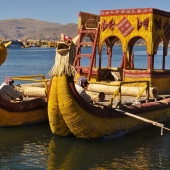
Move Over Machu Picchu & Make Room for Choquequirao
If you knew the existence of Machu Picchu was about to be announced to the world, what would you tell people? The well-known explorer Hiram  Bingham, who is responsible for the Machu Picchu shout out, had no idea how the impact of his disclosure would forever affect future generations. Yet here we are, called in from every corner of the planet, treading in Bingham's footsteps on our way to see for ourselves, the mystery and majesty of the ancient Inca ruins of Machu Picchu.
Bingham, who is responsible for the Machu Picchu shout out, had no idea how the impact of his disclosure would forever affect future generations. Yet here we are, called in from every corner of the planet, treading in Bingham's footsteps on our way to see for ourselves, the mystery and majesty of the ancient Inca ruins of Machu Picchu.
Did you know that Machu Picchu has a sister? Choquequirao ruins, which are only accessible on foot.
In case you missed the chapter on ancient Inca history in high school, the Inca civilization was an industrious culture. They left us hundreds if not thousands of sturdy stone ruins and terraces of assorted size and importance. One of which is the famous ancient citadel of Machu Picchu. The Inca civilization runs the length of the South American Andes Mountains, crossing the borders from Ecuador, Peru, Bolivia and down into to Chile and Argentina. So far, the most popular and perhaps grandest ruins, appears to be Machu Picchu, located in Peru. The Peru government has set up enough infrastructure, to accommodate almost anyone who wishes to endure the trip, for the chance to walk among the authentic stone relics of the ancient Incas.
I'm happy to report that there is not the slightest suggestion of modern convenience allowed inside Machu Picchu national park. You are free to fall from unfenced terraces to your heart's desire, or faint from thirst should you forget to carry a supply of water. Although beware you will now see wooden steps constructed on top of terraces and stones to reduce the impact of thousands of people a day treading on them. Machu Picchu is one of the New 7 Wonders of the World. And to be considered for the World Heritage List by UNESCO, a site "must represent a masterpiece of human creative genius." If you've ever visited the ruins, you know why they deserve this distinction. But all of that could change. Eventually.
Move over Machu Picchu and make room for Choquequirao. The ancient Choquequirao ruins are not far from Machu Picchu, but  nearly impossible to reach, except by hardy trekkers willing to suffer just a bit. Choquequirao ruins occupy a sizeable chunk of real estate, and like Machu Picchu, include remnants of religious structures, homes, terraces for agricultural activity and a network of stone staircases and paths to connect everything. Currently about 5 persons per day make the trek to explore the Choquequirao ruins.
nearly impossible to reach, except by hardy trekkers willing to suffer just a bit. Choquequirao ruins occupy a sizeable chunk of real estate, and like Machu Picchu, include remnants of religious structures, homes, terraces for agricultural activity and a network of stone staircases and paths to connect everything. Currently about 5 persons per day make the trek to explore the Choquequirao ruins.
Adios Adventure Travel has guided many. It takes 5 days with mules, wranglers, guides and porters to get there and back. And includes hiking steep, rocky switchbacks, and a river crossing, that if the bridge is in tact, might be an easy stroll across. But if the bridge is washed out, the only other option is to zing across in an open metal box dangling from a cable attached on each side of the river. You don't really know what you'll find until you get there.
However, the Inca world as we know it, is about to change if plans to construct a cable car to Choquequirao get off the ground. The Peruvian government revived plans to build an aerial tramway to Choququirao ruins. Completion was expected by 2015, but the project got tabled. Until now. Bring in the Choquequrao Cable Car Project in April 2025. That's right. With an estimated investment of $261 million USD, the project titled "Improvement of Public Tourist Services at the Choquequirao Archaeological Park" is expected to attract over one million visitors annually. The Peru Ministry of Foreign Trade and Tourism (Mincetur) are getting their llamas in a row, as well as mucho dinero, to get folks across the expansive Apurimac Valley in 20 minutes.
The drive from Cusco is 4 hours each way on a busy 2-lane winding road. There's no mention of installing train tracks, or constructing an airport in a nearby village. The airport doesn't make sense to me. Unless you build it big enough to handle commercial aircraft, you can't move large groups of people efficiently in small aircraft..
A local airport near Choquequirao is not to be confused with the ongoing building of an International airport near Chinchero. After delays, interruptions, not to mention a pandemic, the Chinchero airport is expected to open any year now.
Once the transportation between Cusco and Choquequirao is figured out, travelers will be able to access and walk among ruins that have barely been seen, let alone touched by modern people. I do feel a little giddy about the opportunity to see this place. But I also understand that once we open that gate, there's no going back. Are we (modern people) ready for this much responsibility? The world is poised to celebrate this exciting opportunity to collectively watch the unfolding of a potential new world heritage site. Maybe this is how Hiram Bingham felt on the eve of his announcement about Machu Picchu?



